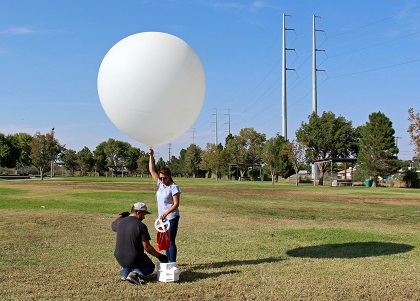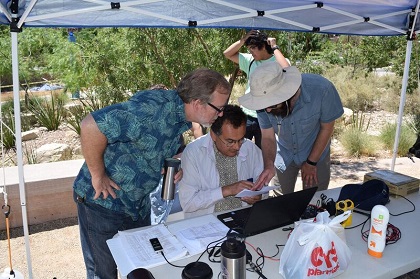 New Mexico State University environmental science undergraduate student Octavio Nayares holds an ozonesonde – an instrument attached to a weather balloon that records and sends data back to the ground. NMSU faculty and students are launching the weather balloons as part of a project with the El Paso Metropolitan Planning Organization and Texas Commission on Environmental Quality. (Photo by Dave DuBois)WRITER: Kristie Garcia, 575-646-4211, kmgarcia@nmsu.edu
New Mexico State University environmental science undergraduate student Octavio Nayares holds an ozonesonde – an instrument attached to a weather balloon that records and sends data back to the ground. NMSU faculty and students are launching the weather balloons as part of a project with the El Paso Metropolitan Planning Organization and Texas Commission on Environmental Quality. (Photo by Dave DuBois)WRITER: Kristie Garcia, 575-646-4211, kmgarcia@nmsu.edu
Students at New Mexico State University are getting hands-on experience launching weather balloons to test ozone levels in the area.
 New Mexico State University environmental science undergraduate student Octavio Nayares (kneeling) and environmental science graduate student Zahra Ghodsi Zadeh (standing) prepare to launch a weather balloon with an ozone level sensor attached. NMSU faculty and students are launching the weather balloons as part of a project with the El Paso Metropolitan Planning Organization and Texas Commission on Environmental Quality. (Photo by Dave DuBois)
New Mexico State University environmental science undergraduate student Octavio Nayares (kneeling) and environmental science graduate student Zahra Ghodsi Zadeh (standing) prepare to launch a weather balloon with an ozone level sensor attached. NMSU faculty and students are launching the weather balloons as part of a project with the El Paso Metropolitan Planning Organization and Texas Commission on Environmental Quality. (Photo by Dave DuBois) New Mexico State University Department of Plant and Environmental Sciences assistant professor Dave DuBois (center) is the principal investigator on a project that uses weather balloons to test ozone levels. NMSU Department of Physics college associate professor Michael DeAntonio (left) is the field coordinator. St. Edward’s University natural sciences research assistant Mark Spychala (right) is also part of the project. (Photo by Gary Morris of St. Edwards University)New Mexico State Climatologist Dave DuBois from the NMSU College of Agricultural, Consumer and Environmental Sciences, is the principal investigator on the project, which is part of a larger project initiated by the State of Texas.
New Mexico State University Department of Plant and Environmental Sciences assistant professor Dave DuBois (center) is the principal investigator on a project that uses weather balloons to test ozone levels. NMSU Department of Physics college associate professor Michael DeAntonio (left) is the field coordinator. St. Edward’s University natural sciences research assistant Mark Spychala (right) is also part of the project. (Photo by Gary Morris of St. Edwards University)New Mexico State Climatologist Dave DuBois from the NMSU College of Agricultural, Consumer and Environmental Sciences, is the principal investigator on the project, which is part of a larger project initiated by the State of Texas.
Along with a combined 10 students from the University of Texas at El Paso and St. Edward's University in Austin, about six NMSU students are launching the weather balloons near El Paso, Texas, and Santa Teresa, New Mexico.
DuBois said the students have taken on quite of bit of responsibility.
"Just by doing the field work, there is a huge sense of teamwork and individual responsibility," DuBois said. "The students are also learning the science part of it. We're looking at the atmosphere and learning about how things change, and we're looking at ozone and why it's important. We're also measuring the weather on a day-to-day basis and observing it on the ground, all the way up to the stratosphere."
DuBois, who is an associate college professor in the NMSU Department of Plant and Environmental Sciences, said he expects to have launched 57 balloons by the end of September. The project began in May. The balloons are equipped with sensors that measure levels of ozone.
"Ozone is an air pollutant regulated by the United States Environmental Protection Agency, and it's the cause of many respiratory illnesses and deaths across the world," DuBois said. "We are working to understand the causes of ozone in El Paso. The sensors attached to the balloons send data back to us regarding the concentration of ozone while the balloon is in the air."
Each balloon ascends as high as 30 kilometers into the stratosphere before it pops and falls to the earth with a parachute.
The Texas Commission on Environmental Quality provides funding to the El Paso Metropolitan Planning Organization, which contracted NMSU to conduct the ozone-measuring part of the project.
Michael DeAntonio, a college professor in the NMSU Department of Physics, is the field coordinator for the weather balloon launches. Along with DuBois and DeAntonio, NMSU students from the Department of Plant and Environmental Sciences, the New Mexico Climate Center, the Department of Physics and the Klipsch School of Electrical and Computer Engineering are working on the project. St. Edward's University in Austin, Texas, along with students from the University of Texas El Paso, are also partners in the project.
"The students are able to see the values change as the balloon rises," DuBois said. "The balloon goes up about five meters per second, and it takes about an hour to go about 30 kilometers – or about 80,000 feet, which is higher than an airplane – before it comes down. If the students are available, they can retrieve the sensor."
DuBois and his team plot the latitude and longitude of each sensor on Google Earth. If the location is accessible, the sensor is retrieved. When it lands in the desert or on farmland, it's more accessible. However, some have landed in Mexico, high up in the Organ Mountains and as far as Artesia, New Mexico. Even if the sensor is not retrieved, the necessary data is collected in real time.
In the event someone from the general public finds a sensor and the shredded balloon, DuBois has attached a phone number, as well as a note in English and Spanish that indicates the device is not dangerous.
"We have a Google phone number set up, so people can immediately call and it goes directly to my cell phone," he said. "I also tape a letter to the top that goes into detail about what we're doing."
Researchers are looking at many factors – including possible pollution from Mexico and Canada – that may contribute to air quality in the United States. Wildfires nearby and in the Pacific Northwest may factor in as well. The oil and gas industry, both on land and in the Gulf of Mexico, may play a part. Even distant locations, such San Antonio, Dallas, Houston, Tucson and Los Angeles may contribute. Because the balloons travel so high up, air masses from that far away may be tracked.
These factors are all just hypotheses at this point. Once all the data is complete, DuBois and his team will begin analyzing the results.
"The goal is to help El Paso make choices regarding efforts toward local emission controls, city planning, fuel for automobiles and transit," DuBois said. "There are dozens of options to change an area like El Paso. If they try to change the patterns of the pollution and change the timing, hopefully the ozone would be affected."
DuBois said this project gives the students a sense of accomplishment.
"We actually see the numbers come in, email the numbers out to get the data quality assured, and then we get it back the same day," he said. "The students also have to prepare the instruments, which takes a couple of hours. Then they actually see the balloon launch and come back down. They have a lot of ownership in the data now, and they've worked very hard."
The students will present their findings of this project at a conference in Austin in January.


